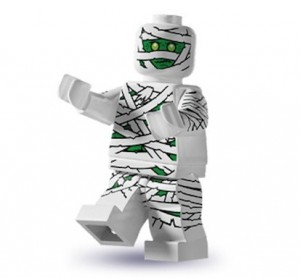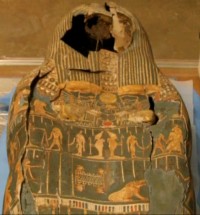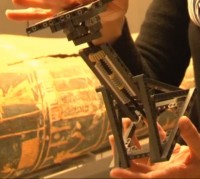 No, not in some arcane ritual imploring Anubis to turn back the twelve hours of the night to re-incarnate a spirit from the netherworld into his mortal remains using Lego minifigures as magical Ushabti.
No, not in some arcane ritual imploring Anubis to turn back the twelve hours of the night to re-incarnate a spirit from the netherworld into his mortal remains using Lego minifigures as magical Ushabti.
Rather, in a project by Cambridge University’s Fitzwilliam Museum to restore a 3000 year old sarcophagus and prepare it for display.
The mummy case, made using a papier–mâché like technique called cartonnage, involving layering strips of linen or papyrus with gum or plaster to create an easily shaped surface, was discovered in the Theban necropolis in a mortuary temple of Ramesses The Great in 1896. It was already damaged, the mummy and its gilded wooden face mask having been robbed out in ancient times.
The case, which had been in storage in the Fitzwilliam Museum for the past 50 years, was decorated in vivid scenes from the Egyptian Book Of The Dead, the mummy it once contained named as Hor.
The museum’s conservators had been studying and restoring the piece in an attempt to make it ready for display. Damage around the torn out mask and the collapsed chest area had been further exacerbated by humidity. Pressure from the weight of the damaged chest was causing long cracks to form throughout the cartonnage. The conservators had concluded they reshape and repair the damage by carefully softening the material with water. However, to do so on the outer surface could easily result in damage to the delicate paintings, and even cause a complete collapse. To effect the repairs the team needed to soften the cartonnage from the inside.
The conservation team contacted David Knowles from Cambridge’s Engineering Department. Knowles constructed a framework using both traditional materials like wood and advanced materials including mouldable medical putty, so Hor’s case could be safely suspended face down for weeks at a time while conservator Sophie Rowe slowly reshaped the cartonnage.
After conservation and restoration were complete another stand was created to hold the case face-up for display. However the delicate 3000 year old papyrus–mâché was still at risk from the simple pressure of gravity.
David Knowles developed six light-weight adjustable A-frames with square support pads out of the popular children’s building brick toy LEGO. Strong enough to add support, yet light enough not to place any additional pressure on the structure of the coffin. Archival foam was used to cushion the frames where the sharp corners and edges of the LEGO made contact with the cartonnage.
The restored inner sarcophagus, which would have fit in a much larger stone or marble sarcophagus, with its remarkable cartoons of the deity Anubis, bearing the disk of the Moon and wishing the traveller a long and prosperous afterlife, and others from the Egyptian Book Of The Dead, is now on display in the Fitzwilliam Museum’s Egyptian Collection.
On a related note, recent genetic studies have shown that mummified animals preserved to honour Anubis, and bearing his likeness, previously thought of as jackals, are actually wolves. Anubis must now be considered the Wolf-headed God, rather than the Jackal.




